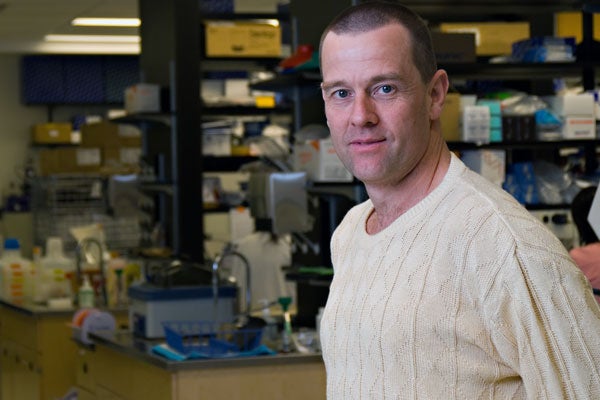
How a U of T scientist is convincing drug companies to fund no-strings research
Published: June 16, 2014
Ten years ago, a medical researcher at the University of Toronto realized something very surprising: patents could be bad for business. Since then, he has convinced nine of the world’s top dozen pharmaceutical companies to invest nearly $100 million in no-strings, open-access research.
Dr. Aled Edwards’ insistence on complete open access makes his collection of laboratories, called the Structural Genomics Consortium, the only model of their kind in the world. Underwritten by Pfizer, Novartis and others, and in a funding partnership with Genome Canada, the Ontario government, and the Wellcome Trust, more than 200 researchers collaborate with more than 200 universities. And they look into some of the darkest, most unchartered corners of the human genome to learn more about what triggers and shuts down cancer and other fatal diseases.
In this setup, staunch competitors share the risks and costs. Then they share their findings with the world.
The model has worked. It has contributed 15 percent of all human protein structures in the public domain and 20 percent of all protein structures from parasites that cause disease. It has led to new drug candidates that are already in clinical trials. And so far, Edwards says, pharmaceutical companies are happy. They’ve found the consortium allows them to do more with less. So much more, that it’s worth giving their competitors a leg up.
“We’re developing tools to study cancer and then giving them to thousands of researchers around the globe,” said Edwards, a professor in the Faculty of Medicine’s Banting and Best Department of Medical Research. “They’re publishing discoveries based on these tools, and the pharma companies benefit from the rapidly expanding knowledge base to make better business decisions. Open access is essential to this model. There is absolutely no way that any single organization could accomplish this amount of research so quickly and cost effectively.”
Last week, SGC celebrated its tenth anniversary with a symposium in Toronto that was about one of its main areas of research: epigenetics, which has been called the next frontier for cancer research.
Cracking the code to the human genome uncovered a new layer of complexity: the epigenome — hundreds of different proteins that switch on and off different DNA molecules at different times. Edwards and his team work on this level, developing ‘chemical probes’ able to turn off some of these proteins that help control our DNA.
The symposium, attended by several hundred scientists from Canada, the U.S., and Europe, showcased new technologies that reveal the way genes are arranged in time and space, and how to analyze smaller and smaller samples. For example, researcher John Dick, professor in the Department of Molecular Genetics at U of T’s Faculty of Medicine, reported a rare pre-leukemic cell with a single mutation in a gene that regulates epigenetics. His lab showed that this altered cell leads to leukemia.
”John’s research highlights the potential for therapies that target epigenetics,” said Edwards. “If we can switch a protein off, and a cancer stem cell reverts to a normal cell, we can guess the protein plays a big role in cancer. But the science is very preliminary, and we really don’t know if this approach is going to work. That’s why it’s perfect for a shared-risk consortium, and far too early to be worrying about patenting. This is the kind of knowledge the whole world should own.”
Heidi Singer is a writer with the Faculty of Medicine at the University of Toronto.



